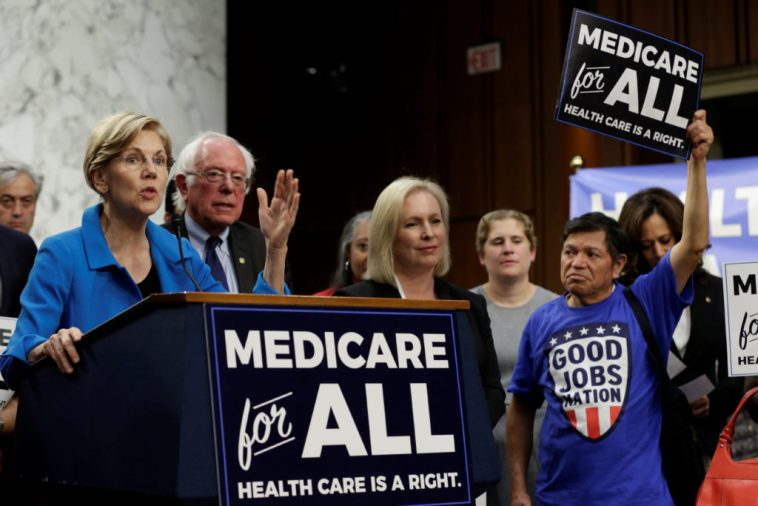The recent analysis released by the Congressional Budget Office reveals unfortunate truths about the financial implications of the Biden administration’s latest Medicare prescription drug premiums plan. The estimates suggest that American taxpayers are likely to shoulder a burden of over $21 billion within the next three years should this scheme come into effect.
This evaluation came into light when several individuals concerned for taxpayer welfare voiced their apprehension. Jason Smith, the House Ways and Means Committee Chairman and Jodey Arrington, the House Budget Committee Chairman, together with Chuck Grassley, the Senate Budget Committee Ranking Member, brought this matter to the attention of Phillip Swagel, the CBO Director.
Swagel’s department confirmed their worst fears, stating that federal spending could experience a surge of between $10 billion and $20 billion by 2025 in contrast to initial expectations. The main driving force behind this shocking rise is an underestimation of federal attributions to changes in the Part D prescription drug coverage plan. This miscalculation led to an enormous 179% increase in the typical plan bid for 2025.
Part D coverage under Medicare typically anticipates monthly reinsurance. To simply put, this means that Medicare payouts offset a portion of the prescription drugs cost after a certain catastrophic threshold is met. It’s worthy to note that almost 60% of Part D participants receive their coverage through Medicare Advantage plans and MA-PD plans.
The remaining Part D beneficiaries are sourced through stand-alone prescription drug plans, which are due for significant changes in 2025 according to the CBO. These reforms include a $15 monthly decrease for PDPs at the cost of $2.9 billion in federal funds, and a cap of $35 for PDP increases in 2024 and 2025 requiring a total of $1.8 billion in federal funding.
Additionally, PDPs with more than 2.5% bids in 2025 can expect to see an increase in risk corridor subsidies. Quite surprisingly, this will result in the extraction of $250 million from federal funds. Concurrent alterations to short-term subsidies and risk corridors are forecasted to boost federal spending by $5 billion by 2025, and an added $2 billion in net spending interest will accumulate by 2034.
Changes made by the Inflation Reduction Act of 2022 have altered the landscape of the Medicare Part D prescription drug benefit. Originally quoted at a budget-friendly $30 million for a span of 10 years from 2025, the alterations have led to an unwelcome alteration.
In response to these significant changes brought about by the act, Medicate prescription drug plan sponsors have felt obliged to increase plan bids and base beneficiary premiums for 2025. Not stopping there, the number of available plans for senior members in 2025 is also being curtailed.
Adding insult to the injury caused by the Medicare Part D changes, CMS, the Centers for Medicare & Medicaid Services intend to funnel federal finances towards substantial health insurance corporations. In addition to stretching out the funds, it falsely deflates the Part D premiums for the elderly, potentially invoking an additional cost of $7 billion by 2025.
The temporary subsidies declared in July 2025 extend to both the enrollee and federal payments to Plan D premiums for the years of 2025, 2026 and 2027. However, rigid and definitive strategies for 2026 and 2027 are yet to be announced, therefore it’s impossible to estimate the budgetary implications for these two years at present.
The budget office is expecting $100 million from each organization that gathers and processes government payments on behalf of Part D plans in 2025. Interestingly enough, it is the Part D participants who would have shouldered this financial burden through their premiums.
The impact of these subsidies on plan revenues is comparatively insignificant when viewed against the colossal federal cost. By dealing out larger federal subsidies to prescription drug plans, the federal payments for Part D plans essentially cover the cost that should have been paid by the Part D members themselves.
In essence, the financial burden of these increased costs switch to the federal payments rather than resting on the shoulders of the Part D enrollees. This is simply another example of the dubious economic principles by which the Democrats are steering Medicare policy.
In the end, this indicates the recklessness with which taxpayer money is being funneled into disastrously conceived Medicare plans. It blatantly exposes the Democrats’ knack for fabricating illusions of cost reduction, when in reality they’re adding to the public’s financial burden.
This imprudent allocation of funds and strategic misdirection is a plain sign of the Democrats’ economic mismanagement. Yet, they continue to boast about these ill-conceived policies instead of learning from their mistakes and strategizing for more beneficial, cost-effective, and sustainable healthcare plans.
As these circumstances unfold, it becomes clear that American taxpayers deserve fiscally responsible leadership that values their hard-earned wealth, not squanders it. That’s why it’s high time to turn our backs on such disastrous Democratic policies and seek alternatives that truly champion fiscal responsibility and sustainability.


